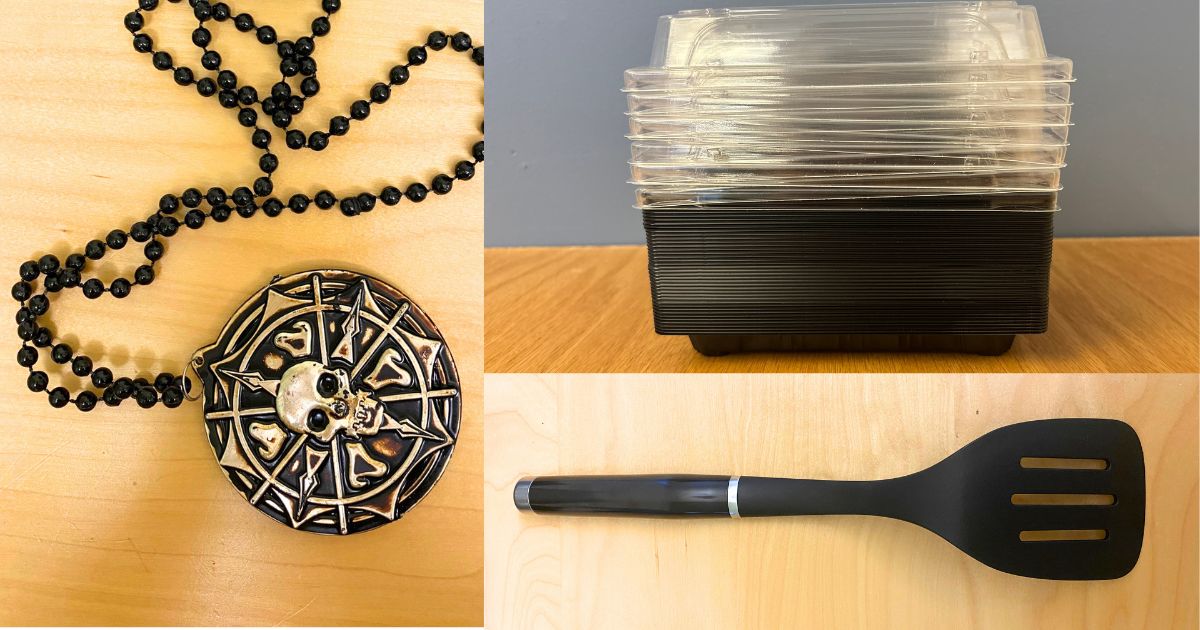Highest levels of toxic flame retardants found in a spatula, sushi tray, and beaded necklace—likely the result of dirty plastic recycling
Toxic-Free Future urges the U.S. and states to ban poison plastics and harmful chemical additives through the Global Plastics Treaty and state policy
SEATTLE, WA — A new peer-reviewed study in Chemosphere finds, for the first-time, certain toxic chemicals in black plastic food-contact items sold in the United States. Led by scientists from Toxic-Free Future and Vrije Universiteit Amsterdam, the testing uncovered high levels of cancer-causing, hormone-disrupting flame retardant chemicals in a variety of household products made with black plastics including food serviceware, kitchen utensils, and toys.
“Companies continue to use toxic flame retardants in plastic electronics, and that’s resulting in unexpected and unnecessary toxic exposures,” explains Megan Liu, study co-author and science and policy manager at Toxic-Free Future. “These cancer-causing chemicals shouldn’t be used to begin with, but with recycling, they are entering our environment and our homes in more ways than one. The high levels we found are concerning.”
The study highlights the consequences of the lack of restrictions on toxic chemicals used in plastics in electronics such as televisions. Recycling of these plastics—typically containing high concentrations of toxic flame retardants—can lead to reuse in household items that do not require flame retardancy. When those household items are high-impact items like toys and kitchen utensils, the result is potentially high and unnecessary dangerous exposures, especially for vulnerable populations such as children and women of childbearing age.
Health concerns related to flame retardants include carcinogenicity, endocrine disruption, neurotoxicity, and reproductive and developmental toxicity, according to the study.
“These results clearly demonstrate that flame retardant-containing electronics, such as the outer casings of large TVs, are being recycled into food storage containers and utensils,” said Heather Stapleton, the Ronie-Richele Garcia-Johnson Distinguished Professor at Duke University. “While it’s critical to develop sustainable approaches when addressing our plastic waste stream, we should exert some caution and ensure we’re not contributing to additional exposures to these hazardous chemicals in recycled materials.”
The study found the highest levels of toxic flame retardants in a sushi tray, spatula, and a beaded necklace. Toxic flame retardant chemicals were found in 85% of analyzed products, with total concentrations ranging up to 22,800 ppm of chemicals including the banned substance deca-BDE and its replacements, such as 2,4,6-tribromophenol, which was also recently detected in breast milk. The banned substance deca-BDE was found at levels ranging from 5 to 1,200 times greater than the European Union’s limit of 10 ppm.
The study also found that plastic typically used in electronics (styrene-based) contained significantly higher levels of toxic flame retardants than plastics less typically used for electronics (polypropylene and nylon). This supported the researcher’s hypothesis that the chemicals are present due to recycling of e-waste into household items.
In November 2024, the U.S. will enter negotiations in Busan, Korea on the Global Plastics Treaty, presenting an important opportunity to advocate for ambitious goals, including annual reductions in plastic production and a ban on hazardous chemicals in plastics, aligning with other high-ambition countries. Toxic-Free Future urges the U.S. and states to ban harmful chemicals in plastics and the most toxic plastics such as PVC and polystyrene through the Global Plastics Treaty and state policy. Following the release of this study, Toxic-Free Future launched a petition to the U.S. government to pass a strong Global Plastics Treaty.
“The Biden administration must support a treaty that will end the use of the most harmful plastics and their toxic additives, even in recycled plastics,” added Megan Liu, study co-author and science and policy manager at Toxic-Free Future. “The solutions are clear. The health of women and children must be prioritized over the chemical industry profits. We need less poison plastic, more safer chemicals and materials, and an end to plastic ingredient secrecy. As world leaders convene in South Korea this November, they have an opportunity to put women’s reproductive health and cancer prevention first by turning off the tap on toxic plastics.”
States have begun to address the use of certain classes of flame retardants. Washington state has the strongest ban in the nation set to take effect January 2025 restricting all organohalogen flame retardants in plastic enclosures for all indoor electronics. New York also has a ban (effective December 2024) on organohalogen flame retardants in plastic enclosures for electronic displays (e.g. televisions and computers).
Earlier research by Toxic-Free Future found that most televisions contained toxic flame retardants. In studies published in 2017 and 2019, Toxic-Free Future found that most companies had replaced the flame retardants polybrominated diphenyl ethers (PBDEs) with members of the same class—organohalogen flame retardants. Studies have shown that chemicals can escape out of products into dust and air inside our homes, travel through wastewater, and pollute homes, waters, the food supply, and even us.
Retailers and brands are increasingly adopting safer chemicals policies to eliminate hazardous chemicals in key product sectors, according to Toxic-Free Future’s Retailer Report Card. Many leading retailers have already adopted voluntary commitments to reduce and eliminate dangerous chemicals like organohalogen flame retardants. In 2022, Best Buy announced display enclosures and stands of all newly designed models of Best Buy’s Exclusive Brand televisions will no longer contain toxic organohalogen flame retardants (OFRs). Instead, they will use a safer flame retardant identified by Best Buy after assessing potential substitutes for hazard. Other leading consumer electronic brands such as Samsung, LG Electronics, and SONY have also taken action to reduce the use of OFRs in the enclosures of televisions they sell.
“Major retailers must ensure the products they sell, from children’s toys to kitchen spatulas, are not introducing banned cancer-causing chemicals into our homes,” said Mike Schade, Toxic-Free Future’s director of Mind the Store. “As businesses introduce more and more recycled materials into everyday products, retailers must require suppliers to test them to ensure toxic chemicals aren’t hiding in these recycled plastics. Retailers must mind the store and prohibit these toxic chemicals in products, especially in recycled plastics.”
TOXIC-FREE FUTURE
Toxic-Free Future is a national leader in environmental health research and advocacy. Through the power of science, education, and activism, Toxic-Free Future drives strong laws and corporate responsibility that protects the health of all people and the planet.
###
MEDIA CONTACT
Stephanie Stohler
[email protected]


 Our Research: Toxic Flame Retardants in Recycled Plastics
Our Research: Toxic Flame Retardants in Recycled Plastics